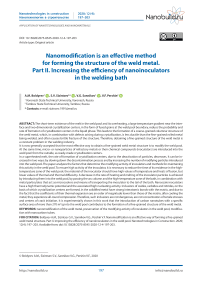Nanomodification is an effective method for forming the structure of the weld metal. Part II. Increasing the efficiency of nanoinoculators in the welding bath
Автор: Boldyrev A.M., Sizintsev S.V., Sannikov V.G., Pershin V.F.
Журнал: Nanotechnologies in Construction: A Scientific Internet-Journal @nanobuild-en
Рубрика: Application of nanotechnologies and nanomaterials
Статья в выпуске: 4 Vol.12, 2020 года.
Бесплатный доступ
The short-term existence of the melt in the weld pool and its overheating, a large temperature gradient near the interface and two-dimensional crystallization centers, in the form of fused grains at the weld pool boundary, reduce the probability and rate of formation of crystallization centers in the liquid phase. This leads to the formation of a coarse-grained columnar structure of the weld metal, which, in combination with defects arising during crystallization, is less ductile than the fine-grained rolled metal being welded, and often causes brittle fracture of the structure. Therefore, obtaining a fine-grained structure of the weld metal is a constant problem in the welding industry. It is now generally accepted that the most effective way to obtain a fine-grained weld metal structure is to modify the weld pool. At the same time, micro- or nanoparticles of refractory metals or their chemical compounds (inoculators) are introduced into the weld pool from the outside, as ready-made crystallization centers. In a superheated melt, the rate of formation of crystallization centers, due to the deactivation of particles, decreases. It can be increased in two ways: by slowing down the decontamination process and by increasing the number of modifying particles introduced into the weld pool. The paper analyzes the factors that determine the modifying activity of inoculators and methods for maintaining this activity in the weld pool. To ensure high activity of the inoculator, it is necessary to reduce the time of its residence in the hightemperature zone of the weld pool; the material of the inoculator should have high values of temperature and heats of fusion, but lower values of thermal and thermal diffusivity. A decrease in the rate of heating and melting of the inoculator particles is achieved by introducing them into the weld pool, by passing the arc column and the high-temperature zone of the bath, in combination with metal particulates that act as microcoolers and means of transporting the inoculator to the tail of the bath. Nanoscale inoculators have a high thermodynamic potential and the associated high nucleating activity. Inclusions of oxides, carbides and nitrides, on the basis of which crystallization centers are formed, in the solidified metal have strong interatomic bonds with the matrix, and due to the fact that the coefficients of their thermal expansion are an order of magnitude lower than those of the matrix, after cooling the metal, they experience all-round compression. Therefore, such inclusions are not dangerous, are not concentrators of tensile stresses and centers of crack initiation. It is experimentally shown in this work that the introduction of carbon nanotubes with a specific surface area of more than 270 m2/g into the weld pool contributes to the formation of a fine-grained structure of the weld metal.
Nanomodification of the weld metal, preservation of the modifying activity of inoculators in the weld pool, modification with nanocarbon tubes
Короткий адрес: https://sciup.org/142226966
IDR: 142226966 | DOI: 10.15828/2075-8545-2020-12-4-197-203
Список литературы Nanomodification is an effective method for forming the structure of the weld metal. Part II. Increasing the efficiency of nanoinoculators in the welding bath
- Boldyrev A.M., Grigorash V.V. Problems of micro- and nano-modification of seams during welding of building metal structures. Nanotechnologies in Сonstruction. 2011; 3(3): 42-52. Available from: http://nanobuild.ru/ru_RU/journal/Nanobuild_3_2011_RUS.pdf [Accessed 14th August 2020]. (In Russian).
- Balandin G.F. Formation of the crystal structure of castings. Moscow: Mechanical engineering; 1973. (In Russian).
- Dankov P.A. Crystal-chemical mechanism of interaction of the crystal surface with foreign ele-mentary particles. Physical chemistry. 1946;8: 853-867. (In Russian).
- Kalinina A.P., Cherepanov A.N., Poluboyarov V.A., Korotaeva Z.A. Mathematical model of nu-cleation in liquid metals on ultradispersed ceramic particles. Journal of Physical Chemistry. 2001; 75(2): 275-281. (In Russian).
- Boldyrev A.M., Petrov A.S., Dorofeev E.B. Method of electric arc welding. Invention certificate USSR No. 584996 Cl V 23 K 9/00, 17.04.76. (In Russian).
- Boldyrev A.M., Grigorash V.V., Gushchin D.A., Grebenchuk V.G. Investigation of the adhesion strength of particles in a modifying additive for submerged arc welding of bridge structures. Nano-technologies in Сonstruction. 2012;4(2): 56–69. Available from: http://nanobuild.ru/ru_RU/journal/Nanobuild_2_2012_RUS.pdf. [Accessed 14th August 2020]. (In Russian).
- Aleshin N.P., Yakushin B.F., Kobernik N.V., Kilev V.S. Improvement of the process of cold-resistant steels by optimizing the balance of thermal energy of an arc source. Welding production. 2018;10: 3-13. (In Russian).
- Fedyukin S.V., Karasev M.V., Kolodyazhny D.Yu., Zhuk V.V. A new generation of industrial import-substituting inverter welding machines for mechanized gas-shielded metal electrode welding of a standard type and with separation of the arc and short circuit phase control. Welding and Diag-nostics. 2017;5: 49-53. (In Russian).
- Golovko V.V., Boldyrev A.M., Gushchin D.A., Kuznetsov V.D., Fomichev S.K., Smirnov I.V. Peculiarities of distribution and the role of non-metallic inclusions in the weld metal when nano-oxides are introduced into the weld pool. Welding and diagnostics. 2015;6: 25-29. (In Russian).
- Ma, Z.T., Janke D. Oxide metallurgy-its purposes and practical approaches. Acta Metall. 1998;11(2): 79-86.
- Davydov S.V. Nanomodifier as a tool for genetic engineering of the structural state of cast iron melt. Collection of reports of the Foundry Council No. 1 ≪Modification as an effective tool for im-proving the quality of cast iron and steels≫. Chelyabinsk: Chelyabinsk House of Press; 2006. (In Russian).


